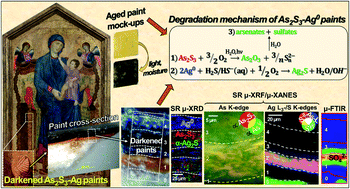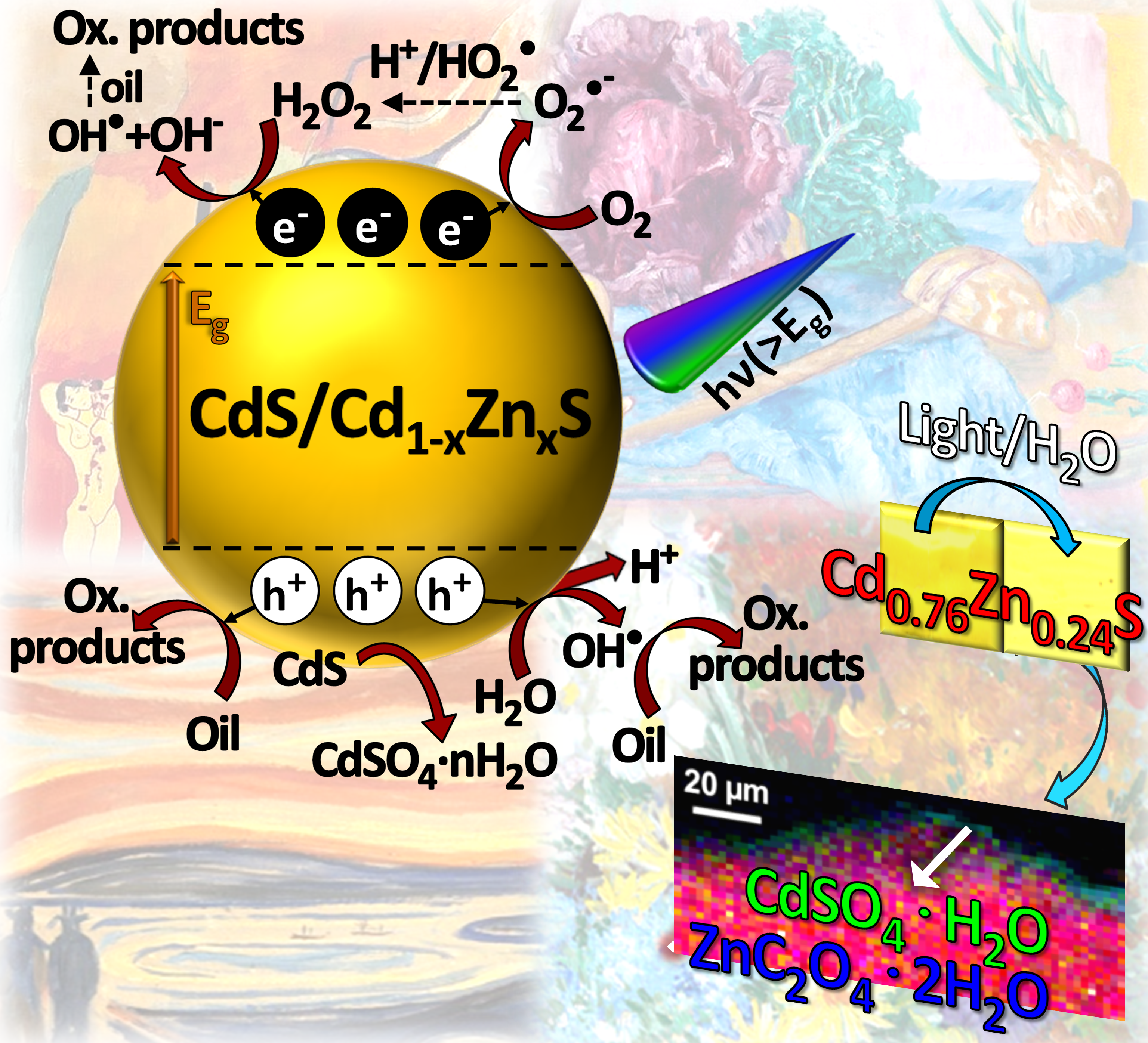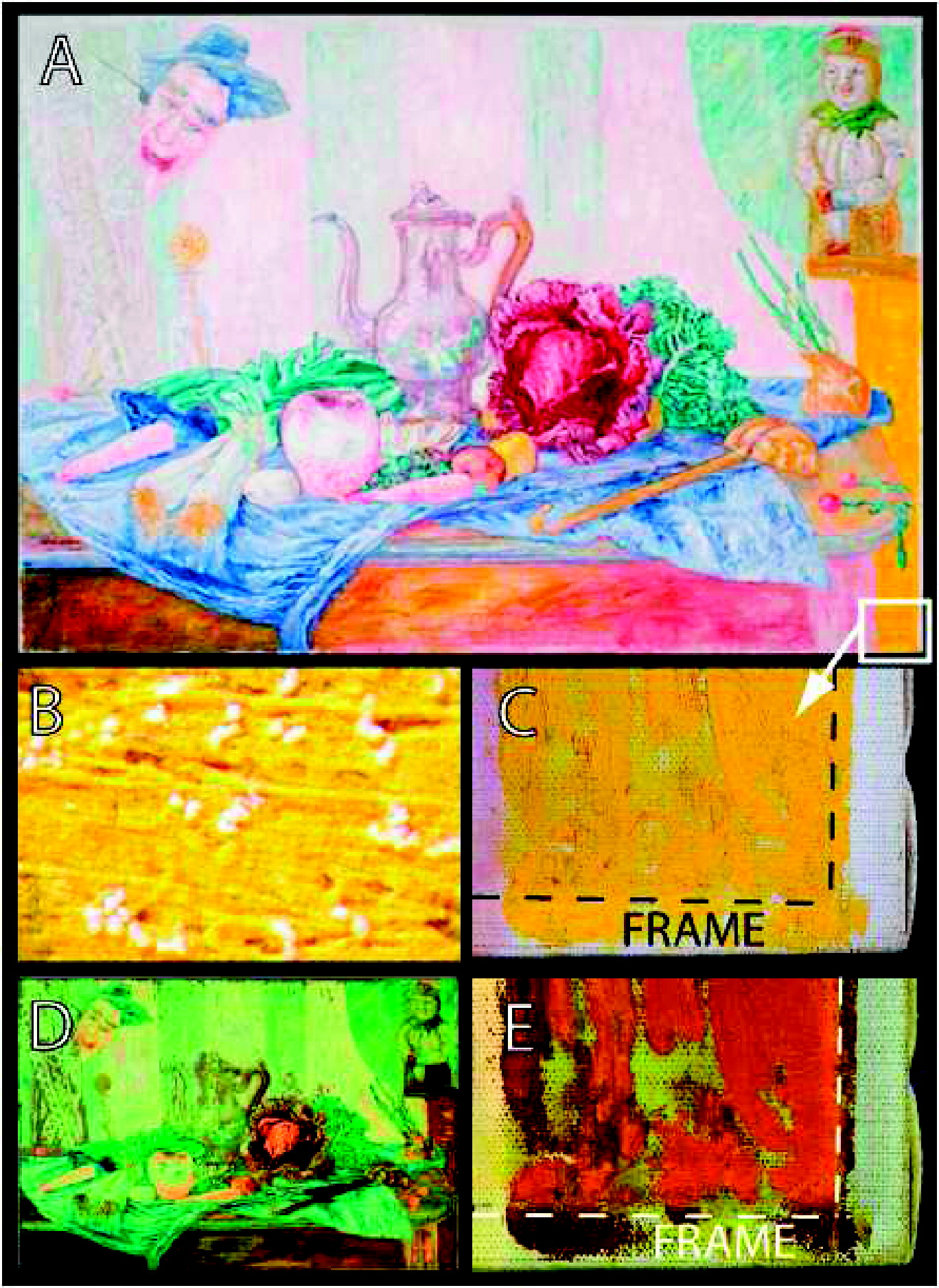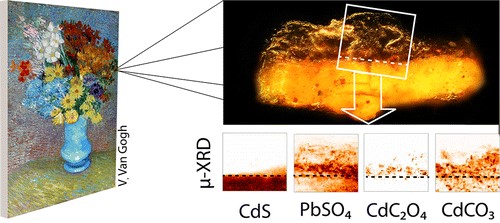Cadmium yellows and arsenic sulfides
Degradation of cadmium yellow pigments and arsenic sulfide pigments
Cadmium sulphide exists in two crystalline and one amorphous form. The hexagonal form (![]() -CdS) is found in nature as the mineral greenockite while the cubic form (ß-CdS) is called hawleyite; greenockite is frequently used as yellow pigment in modern paints. Manufacturers started to make intense use of this pigment from the moment cadmium became commercially available as a base material (around the 1840’s). This popularity was mainly due to the pigment’s high tinting and covering power, bright yellow colour, wide applicability (artists’ paint, metallurgy, ceramics, medical use, etc.) and suitability for mass production. In addition, at the beginning of the 20th century, CdS was thought to be highly stable in oil paint and water colours, which was not the case for chrome yellow, the only bright yellow alternative available for painting at that time. Consequently, prominent 19th-20th century painters such as Claude Monet, Vincent Van Gogh and Pablo Picasso frequently employed CdS, as was amply documented by earlier analytical research. Yet, in spite of its excellent reputation with regards to permanency, fading of the yellow colour of CdS and loss of adhesion of the oil paint has been reported. The different experiments performed in this context at ID21 aimed i) at understanding the composition of fragments from historical paintings (by Matisse, Van Gogh, Ensor), in particular the original pigment and its synthesis side products as well as degradation products and ii) performing similar studies on model paints aged in controled conditions.
-CdS) is found in nature as the mineral greenockite while the cubic form (ß-CdS) is called hawleyite; greenockite is frequently used as yellow pigment in modern paints. Manufacturers started to make intense use of this pigment from the moment cadmium became commercially available as a base material (around the 1840’s). This popularity was mainly due to the pigment’s high tinting and covering power, bright yellow colour, wide applicability (artists’ paint, metallurgy, ceramics, medical use, etc.) and suitability for mass production. In addition, at the beginning of the 20th century, CdS was thought to be highly stable in oil paint and water colours, which was not the case for chrome yellow, the only bright yellow alternative available for painting at that time. Consequently, prominent 19th-20th century painters such as Claude Monet, Vincent Van Gogh and Pablo Picasso frequently employed CdS, as was amply documented by earlier analytical research. Yet, in spite of its excellent reputation with regards to permanency, fading of the yellow colour of CdS and loss of adhesion of the oil paint has been reported. The different experiments performed in this context at ID21 aimed i) at understanding the composition of fragments from historical paintings (by Matisse, Van Gogh, Ensor), in particular the original pigment and its synthesis side products as well as degradation products and ii) performing similar studies on model paints aged in controled conditions.
The deterioration of cadmium yellow paints in artworks by Joan Miró (1893–1983) and in painting materials from his studios in Mallorca (Spain) was investigated. Analysis of samples from Miró’s paintings and from paint tubes and palettes showed that degraded paints are composed of poorly crystalline cadmium sulfide/zinc cadmium sulfide (CdS/Cd1−xZnxS) with a low percentage of zinc, in an oil binding medium. Cadmium sulfates were identified as the main deterioration products, forming superficial white crusts detected using SR µXANES and µXRD techniques. Time-resolved photoluminescence measurements demonstrated that highly degraded samples display a pink/orange emission from the paint surface with a microsecond lifetime, a phenomenon observed in other degraded cadmium yellow paints. In agreement with recent studies on altered cadmium paints, these results suggest that the stability of the paint is related to its manufacturing method, which affects the degree of crystallinity of the resulting pigment. This, together with the environmental conditions in which artworks have been exposed, have induced the degradation of yellow paints in Miró’s artworks. It was finally noted that the paints exhibiting alteration in the analysed Miró artworks have a chemical composition that is very similar to the tube paint ‘Cadmium Yellow Lemon No. 1’ produced by Lucien Lefebvre-Foinet. Indeed, paint tubes from this brand were found in the studio, linking the use of this product with Miro’s degraded artworks.
 |
L. Monico, S. Prati, G. Sciutto, E. Catelli, A. Romani, D. Quintero Balbas, Z. Li, S. De Meyer, G. Nuyts, K. Janssens, M. Cotte, J.Garrevoet, G. Falkenberg, V. Tardillo Suárez, R. Tucoulou and R. Mazzeo, "Development of a multi-method analytical approach based on the combination of synchrotron radiation X-ray micro-analytical techniques and vibrational micro-spectroscopy methods to unveil the causes and mechanism of darkening of “fake-gilded” decorations in a Cimabue painting", Journal of Analytical Atomic Spectrometry, (2021)
|
Redox processes activated by environmental factors have been identified as the main cause of the chromatic alterations of a number of artists’ pigments, including the yellow pigment orpiment (As2S3). Although a general comprehension of the mechanisms has been provided through characterization of degradation compounds of As2S3, experimental evidences to prove how other paint components and how different environmental agents influence the formation pathways of specific secondary compounds are still lacking. Thus, it becomes fundamental to develop a methodological strategy which enable achieving a discrimination among the causes affecting the chemical stability of more heterogenous As2S3-based paints and defining the mechanism through which the alteration establishes and evolves, with the ultimate goal of optimizing the preventive conservation measures of unique masterpieces. In this paper, we propose a comprehensive multi-material and multi-method approach based on the combination of synchrotron radiation X-ray micro-analytical techniques (i.e., X-ray diffraction, X-ray fluorescence and X-ray absorption near edge structure spectroscopy at S K-/Ag L3-/As K-edges) and vibrational micro-spectroscopy methods to unveil the causes and mechanism of darkening of “fake-gilded” decorations in tempera paintings, originally consisting of an unusual mixture of As2S3 and metallic silver (Ag0). Such degradation process is a not yet understood phenomenon threatening a series of Old Master paintings, including those by the Italian painters Cimabue and Pietro Lorenzetti. The high specificity, sensitivity and lateral resolution of the employed analytical methods allowed providing first-time evidence for the presence of black acanthite (α-Ag2S), mimetite [Pb5(AsO4)3Cl] and syngenite [K2Ca(SO4)2∙H2O] as degradation products of the “fake-gilded” decorations in the Maestà by Cimabue (Church of Santa Maria dei Servi, Bologna, Italy). Furthermore, the study of the painting combined with that of tempera paint mock-ups permitted to explore and define the environmental agents and internal factors causing the darkening, by proving that: (i)Ag0 and moisture are key-factors for triggering the transformation of As2S3 to α-Ag2S and As-oxides; (ii)S2--ions arising from the degradation of As2S3 are the main responsible for the formation of α-Ag2S; (iii)light exposure strengthens the tendency of the paint components towards alteration. Based on our findings, we finally propose a degradation mechanism of As2S3/Ag0-based tempera paints.
|
L. Monico, L. Cartechini, F. Rosi, A. Chieli, C. Grazia, S. De Meyer, G. Nuyts, F. Vanmeert, K. Janssens, M. Cotte, W. De Nolf, G. Falkenberg, I. C. A. Sandu, E. S. Tveit, J. Mass, R. P. de Freitas, A. Romani and C. Miliani, "Probing the chemistry of CdS paints in The Scream by in situ noninvasive spectroscopies and synchrotron radiation x-ray techniques", Science Advances, 6, eaay3514 (2020). |
The degradation of cadmium sulfide (CdS)–based oil paints is a phenomenon potentially threatening the iconic painting The Scream (ca. 1910) by Edvard Munch (Munch Museum, Oslo) that is still poorly understood. Here, we provide evidence for the presence of cadmium sulfate and sulfites as alteration products of the original CdS-based paint and explore the external circumstances and internal factors causing this transformation. Macroscale in situ noninvasive spectroscopy studies of the painting in combination with synchrotron-radiation x-ray microspectroscopy investigations of a microsample and artificially aged mock-ups show that moisture and mobile chlorine compounds are key factors for promoting the oxidation of CdS, while light (photodegradation) plays a less important role. Furthermore, under exposure to humidity, parallel/secondary reactions involving dissolution, migration through the paint, and recrystallization of water-soluble phases of the paint are associated with the formation of cadmium sulfates.
 |
Monico, L., Chieli, A., De Meyer, S., Cotte, M., de Nolf, W., Falkenberg, G., ... & Miliani, C. "Role of relative humidity and Cd/Zn stoichiometry in the photo‐oxidation process of cadmium yellows (CdS/Cd1‐xZnxS) in oil paintings". Chemistry–A European Journal (2018), 24(45), 11584-11593. |
Cadmium yellows (CdYs) refer to a family of cadmium sulfide pigments which have been widely used by artists since the late 19th c. Despite being considered stable, they are suffering from discoloration in iconic paintings, such as Joy of Life by Matisse, Flowers in a blue vase by Van Gogh and the Scream by Munch, most likely due to the formation of CdSO₄·nH₂O. Questions about what the factors driving the CdYs degradation are and how they affect the overall process are still open. Here, we study a series of oil mock‐up paints made of CdYs of different stoichiometry (CdS/Cd₀.₇₆Zn₀.₂₄S) and crystalline structure (hexagonal/cubic) before and after aging at variable relative humidity under exposure to light and in darkness. Synchrotron‐based X‐ray methods combined with UV‐Visible and FTIR spectroscopies show that: (i) Cd₀.₇₆Zn₀.₂₄S is more susceptible to photo‐oxidation than CdS; both compounds can act as photocatalysts for the oil oxidation. (ii) The photo‐oxidation of CdS/Cd₀.₇₆Zn₀.₂₄S to CdSO₄·nH₂O is triggered by moisture. (iii) The nature of alteration products depends on the aging conditions and Cd/Zn stoichiometry. Based on our findings, we propose a scheme for the mechanism of the photocorrosion process and photocatalytic activity of CdY pigments in the oil binder. Overall, our results form a reliable basis for understanding the degradation of CdS‐based paints of artworks and contribute towards developing better ways of preserving them for future generations.
 |
E. Pouyet, M. Cotte, B. Fayard, M. Salomé, F. Meirer, A. Mehta, E. S. Uffelman, A. Hull, F. Vanmeert, J. Kieffer, M. Burghammer, K. Janssens, F. Sette and J. Mass, "2D X-ray and FTIR micro-analysis of the degradation of cadmium yellow pigment in paintings of Henri Matisse", Applied Physics A, 121, 967 (2015). |
The chemical and physical alterations of cadmium yellow (CdS) paints in Henri Matisse’s The Joy of Life (1905–1906, The Barnes Foundation) have been recognized since 2006, when a survey by portable X-ray fluorescence identified this pigment in all altered regions of the monumental painting. This alteration is visible as fading, discoloration, chalking, flaking, and spalling of several regions of light to medium yellow paint. Since that time, synchrotron radiation-based techniques including elemental and spectroscopic imaging, as well as X-ray scattering have been employed to locate and identify the alteration products observed in this and related works by Henri Matisse. This information is necessary to formulate one or multiple mechanisms for degradation of Matisse’s paints from this period, and thus ensure proper environmental conditions for the storage and the display of his works. This paper focuses on 2D full-field X-ray Near Edge Structure imaging, 2D micro-X-ray Diffraction, X-ray Fluorescence, and Fourier Transform Infra-red imaging of the altered paint layers to address one of the long-standing questions about cadmium yellow alteration—the roles of cadmium carbonates and cadmium sulphates found in the altered paint layers. These compounds have often been assumed to be photo-oxidation products, but could also be residual starting reagents from an indirect wet process synthesis of CdS. The data presented here allow identifying and mapping the location of cadmium carbonates, cadmium chlorides, cadmium oxalates, cadmium sulphates, and cadmium sulphides in thin sections of altered cadmium yellow paints from The Joy of Life and Matisse’s Flower Piece (1906, The Barnes Foundation). Distribution of various cadmium compounds confirms that cadmium carbonates and sulphates are photo-degradation products in The Joy of Life, whereas in Flower Piece, cadmium carbonates appear to have been a [(partially) unreacted] starting reagent for the yellow paint, a role previously suggested in other altered yellow paints.
 |
K. Keune, J. Mass, F. Meirer, C. Pottasch, A. van Loon, A. Hull, J. Church, E. Pouyet, M. Cotte and A. Mehta, "Tracking the transformation and transport of arsenic sulfide pigments in paints: synchrotron-based X-ray micro-analyses", Journal of Analytical Atomic Spectrometry, 30, 813-827 (2015). |
Realgar and orpiment, arsenic sulfide pigments used in historic paints, degrade under the influence of light, resulting in transparent, whitish, friable and/or crumbling paints. So far, para-realgar and arsenic trioxide have been identified as the main oxidation products of arsenic sulfide pigments. This paper shows that after photo-degradation, various oxidation and migration processes take place. Synchrotron radiation (SR) micro-X-ray fluorescence (μ-XRF) reveals arsenic to be distributed throughout the whole multi-layered paint system. Arsenic (As) K-edge micro-X-ray absorption near edge structure (μ-XANES) analyses indicate the presence of an intact AsxSy pigment, arsenite compounds (As3+; As2O3), and arsenate compounds (As5+); the latter are certainly present as calcium, lead, aluminium and iron arsenates. Sulfur (S) K-edge μ-XANES points to the conversion of the sulfide (S2−) group to a sulfate (SO42−) group, probably via an elemental sulfur (S0) or sulfoxide (S2+) compound. Principal Component Analysis (PCA) and subsequent k-means clustering of multi-energy SR μ-XRF maps and μ-XANES were performed to identify the various arsenic species and visualize their distribution. The arsenates (As5+) are spread throughout the entire paint system and dominate the photo-degraded paint and ground layers, while the arsenite compounds (As3+) are located close to the intact arsenic sulfide pigment. The oxidation of arsenic trioxide into arsenates likely takes place in aqueous solutions. The presence of As5+compounds in the paint systems indicates that the arsenic trioxide is dissolved by ambient water present in the paint. Arsenite and arsenate compounds are water soluble and are transported by water throughout the paint system. This knowledge is crucial for the conservation field, as this is the first time that (indirect) evidence of water transport within paintings has been given.
 |
J. L. Mass, R. Opila, B. Buckley, M. Cotte, J. Church and A. Mehta, "The photodegradation of cadmium yellow paints in Henri Matisse’s Le Bonheur de vivre (1905–1906)", Applied Physics A, 111, 59-68 (2013). |
Evidence for the alteration of the yellow paints in Henri Matisse’s Le Bonheur de vivre (1905–1906, The Barnes Foundation) has been observed since the 1990s. The changes in this iconic work of Matisse’s Fauvist period include lightening, darkening, and flaking of the yellow paints. Handheld X-ray fluorescence (XRF) and multispectral imaging surveys reveal that the degradation is confined to cadmium yellow (CdS) paints. The discoloration of cadmium yellow paints in Impressionist, Post-Impressionist and early modernist work from the 1880s through the 1920s has been ascribed to the photo-oxidative degradation of CdS. Preliminary investigations of the degraded yellow paints in this work involved Cd LIII-edge X-ray Absorption Near Edge Spectroscopy (XANES) at the Stanford Synchrotron Radiation Light Source (SSRL Menlo Park, California) and Scanning Electron Microscopy-energy dispersive X-ray analysis (SEM-EDS) at the Winterthur Museum Scientific Research and Analysis Laboratory. To determine if the visual changes in the paints did in fact indicate photo-oxidative degradation and if different chemistries could be observed for the lightened versus darkened regions, synchrotron radiation-micro Fourier Transform InfraRed (SR-μFTIR) spectroscopy, X-ray Fluorescence (SR-μXRF) mapping and micro X-ray Absorption Near Edge Spectroscopy (μXANES) mapping at the Cd LIII-edge of the altered paint cross-sections were carried out at the European synchrotron radiation facility (ESRF, Grenoble, France) beamline ID-21. The goal is to elucidate the discoloration mechanisms observed in the paint using elemental and speciation mapping. The μXANES mapping and SR-FTIR imaging showed a substantial enrichment of CdCO3 in the off-white surface crust of the faded/discolored CdS paint. This suggests that the CdCO3 is present as an insoluble photodegradation product rather than solely a paint filler or starting reagent. Additionally, oxalates and sulfates were found to be concentrated at the alteration surface.
|
G. Van der Snickt, K. Janssens, J. Dik, W. De Nolf, F. Vanmeert, J. Jaroszewicz, M. Cotte, G. Falkenberg and L. Van der Loeff, "Combined use of Synchrotron Radiation Based Micro-X-ray Fluorescence, Micro-X-ray Diffraction, Micro-X-ray Absorption Near-Edge, and Micro-Fourier Transform Infrared Spectroscopies for Revealing an Alternative Degradation Pathway of the Pigment Cadmium Yellow in a Painting by Van Gogh", Analytical Chemistry, 84, 10221–10228 (2012). |
|
Over the past years a number of studies have described the instability of the pigment cadmium yellow (CdS). In a previous paper we have shown how cadmium sulfide on paintings by James Ensor oxidizes to CdSO4·H2O. The degradation process gives rise to the fading of the bright yellow color and the formation of disfiguring white crystals that are present on the paint surface in approximately 50 μm sized globular agglomerations. Here, we study cadmium yellow in the painting “Flowers in a blue vase” by Vincent van Gogh. This painting differs from the Ensor case in the fact that (a) a varnish was superimposed onto the degraded paint surface and (b) the CdS paint area is entirely covered with an opaque crust. The latter obscures the yellow color completely and thus presents a seemingly more advanced state of degradation. Analysis of a cross-sectioned and a crushed sample by combining scanning microscopic X-ray diffraction (μ-XRD), microscopic X-ray absorption near-edge spectroscopy (μ-XANES), microscopic X-ray fluorescence (μ-XRF) based chemical state mapping and scanning microscopic Fourier transform infrared (μ-FT-IR) spectrometry allowed unravelling the complex alteration pathway. Although no crystalline CdSO4 compounds were identified on the Van Gogh paint samples, we conclude that the observed degradation was initially caused by oxidation of the original CdS pigment, similar as for the previous Ensor case. However, due to the presence of an overlying varnish containing lead-based driers and oxalate ions, secondary reactions took place. In particular, it appears that upon the photoinduced oxidation of its sulfidic counterion, the Cd2+ ions reprecipitated at the paint/varnish interface after having formed a complex with oxalate ions that themselves are considered to be degradation products of the resin and/or oil in the varnish. The SO42– anions, for their part, found a suitable reaction partner in Pb2+ ions stemming from a dissolved lead-based siccative that was added to the varnish to promote its drying. The resulting opaque anglesite compound in the varnish, in combination with the underlying CdC2O4 layer at the paint/varnish interface, account for the orange-gray crust that is disfiguring the painting on a macroscopic level. In this way, the results presented in this paper demonstrate how, through a judicious combined use of several microanalytical methods with speciation capabilities, many new insights can be obtained from two minute, but highly complex and heterogeneous paint samples.
 |
G. van der Snickt, J. Dik, M. Cotte, K. Janssens, J. Jaroszewicz, W. De Nolf, J. Groenewegen and L. van der Loeff, "Characterization of a degraded cadmium yellow (CdS) pigment in an oil painting by means of synchrotron radiation based X-ray techniques", Analytical Chemistry, 81, 2600-2610 (2009). |
On several paintings of James Ensor (1860−1949), a gradual fading of originally bright yellow areas, painted with the pigment cadmium yellow (CdS), is observed. Additionally, in some areas exposed to light, the formation of small white-colored globules on top of the original paint surface is observed. In this paper the chemical transformation leading to the color change and to the formation of the globules is elucidated. Microscopic X-ray absorption near-edge spectroscopy (μ-XANES) experiments show that sulfur, originally present in sulfidic form (S2−), is oxidized during the transformation to the sulfate form (S6+). Upon formation (at or immediately below the surface), the highly soluble cadmium sulfate is assumed to be transported to the surface in solution and reprecipitates there, forming the whitish globules. The presence of cadmium sulfate (CdSO4·2H2O) and ammonium cadmium sulfate [(NH4)2Cd(SO4)2] at the surface is confirmed by microscopic X-ray diffraction measurements, where the latter salt is suspected to result from a secondary reaction of cadmium sulfate with ammonia. Measurements performed on cross sections reveal that the oxidation front has penetrated into the yellow paint down to ca. 1−2 μm. The morphology and elemental distribution of the paint and degradation product were examined by means of scanning electron microscopy equipped with an energy-dispersive spectrometer (SEM-EDS) and synchrotron radiation based micro-X-ray fluorescence spectrometry (SR μ-XRF). In addition, ultraviolet-induced visible fluorescence photography (UIVFP) revealed itself to be a straightforward technique for documenting the occurrence of this specific kind of degradation on a macroscale by painting conservators.




